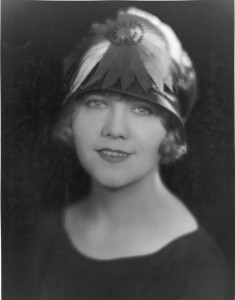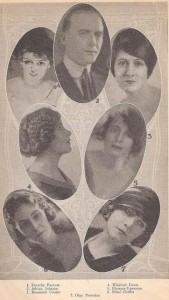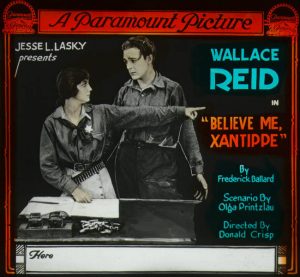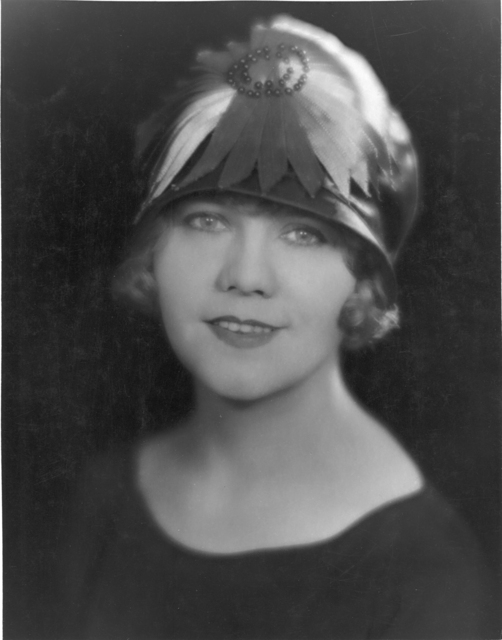by
Denise McKenna
Olga Printzlau was a prolific writer who began her career as an artist, but turned to screenwriting after becoming interested in the “literary possibilities” of film. By 1920 she was credited with having written 352 produced scenarios (“Olga Printzlau to Write” 183). During the twenties she was sought after for her skill in adapting popular stories and novels to the screen, most notably F. Scott Fitzgerald’s The Beautiful and the Damned (1922) and Edith Wharton’s The Age of Innocence (1924). But by the late 1920s Printzlau’s attention seems to have turned more to her theatre work, and her film career dwindles significantly after 1930, with no known screen credits after 1933.

Olga Printzlau portrait. Private Collection.
While it is not clear when Printzlau first began working in the film industry, she was employed at the Majestic Film Company in 1914, the same year she married actor Hal Clements. A few years later, she was promoted as the “sensation of New York” in the advertising campaign for “To Honor and Obey” (1917) that was adapted from one of her stories. Printzlau worked for a number of companies during her career, although from 1915 to about 1918 she worked most often for Universal. In the late teens she began writing for Famous Players, and in 1920 Printzlau signed a five-year contract with Famous Players to write exclusively for William deMille (183). Although the details are not known, this contract seems to have been broken sometime around 1922 when she was engaged by Warner Brothers to adapt The Beautiful and the Damned. In 1923 she signed another exclusive contract with the short-lived B. P. Schulberg productions to head a new adaptation department, supervising a dozen writers in adapting stories and stage plays for Al Lichtman attractions. Along with well-known scenarist Eve Unsell, who was in charge of the original story department, Printzlau was hired as part of Schulberg’s new “integral” system that was to rationalize production under the studio head rather than the director (“Efficiency in Photoplays”). She returned to Warner Brothers for another high-profile adaptation of the Pulitzer Prize-winning The Age of Innocence. By 1925, in a Los Angeles Times article describing the progress of women screenwriters, Printzlau is identified as a successful freelancer who is able to command a $500 a week salary (C10).
In 1927 she adapted yet another famous novel to screen for First National. She notes with some humor that Camille had been filmed so many times “it would seem the canvas square reflecting her grief would hang limp and lugubrious with her lachrymose outbursts.” Despite her somewhat unsympathetic response to Camille’s tearful existence, she was confident enough in the film to proclaim that her adaptation surpassed all others in terms of length, artistry, and circulation (“Camille has Walkaway”).
Printzlau was also a thoughtful observer of the photodramatist’s work. She published two brief essays on screenwriting in the Christian Science Monitor, describing her thoughts on the challenges of adaptations and her assessment of scenario writing’s mass appeal. In both articles she defends screenwriting as an art, comparing the photodramatist’s tools of “imagination and symbol” to Michelangelo’s chisels and marble. For Printzlau, the “conscientious” writer should avoid using too much written information on the screen, an effect she likens to attaching real hair on a marble sculpture. Perfection in screenwriting is the “wordless” screen drama that relies only on the image and the symbolic potential of everyday objects to convey meaning (“Making Thoughts Visible”). She rebukes would-be writers who assume that writing for the screen is easy, observing that screenwriting is like laying out the patterns of a mosaic, an art that “requires patience, dexterity and vision” (“Ambition vs. Obsession”).

“The Truth About the Movies,” Dorothy Farnum, Winifred Dunn, Florence Lawrence, Olga Printzlau, Ethel Chaffin, and Rosemary Cooper. Private Collection.
Printzlau’s interest in symbolism carried over into her theatre work, particularly her 1925 play “Window Panes,” which was published by S. French in 1932 and revived on stage in 1939. Other stage plays include: “Manna” (1924), “The Jay Walker” (1926), “The Showdown” (1927), “Back Here” (1928), “Little Heaven” (1928), and “The Ostrich” (1930).
See also: “Shaping the Craft of Screenwriting: Women Screen Writers in Silent Era Hollywood”
Bibliography
“Camille Has Walkaway in Classic Heroine Handicap.” Los Angeles Times (13 Feb. 1927): C21.
“Efficiency in Photoplays."” Los Angeles Times (20 Jan. 1923): II1.
“Olga Printzlau to Write for Famous Players Corporation.”Moving Picture World (11 Sept.1920): 183.
Printzlau, Olga. “Ambition vs. Obsession in Writing for the Motion Picture Screen.” Christian Science Monitor (27 Jun. 1922): 6.
Printzlau, Olga. “Making Thoughts Visible in Photoplay Composition.” Christian Science Monitor (22 Aug. 1922):16.
Williams, Whitney. “Penwomen Dominate Screen Literati Group.” Los Angeles Times (19 Nov. 1924): C10.
Filmography
A. Archival Filmography: Extant Film Titles:
1. Olga Printzlau as Screenwriter
The Seekers. Dir.: Otis Turner, sc.: Olga Printzlau, Otis Turner (Universal Film Mfg. Co., Inc. US 1916) Cas.: Flora De Haven, Paul Byron, Charles Hill Mailes, si, b&w, 35mm, 1 reel. Archive: Library of Congress, Library and Archives Canada.
When Little Lindy Sang. Prod./dir.: Lule Warrenton, sc.: Olga Printzlau (Powers Film Co. US 1916) cas.: Ernestine Jones, Nora Dempsey, Margaret Whistler, si, b&w, 35mm., 1 reel. Archive: Library of Congress.
Conrad in Quest of His Youth. Dir. William C. DeMille, sc.: Olga Printzlau (Famous Players-Lasky Corp. US 1920) cas.: Thomas Meighan, Mabel Van Buren, si., b&w. 35mm. Archive: Library of Congress, George Eastman Museum, BFI National Archive, UCLA Film & Television Archive.
Jack Straw. Dir.: William C. DeMille, sc.: Olga Printzlau, Elmer Harris (Famous Players-Lasky Corp. US 1920) cas.: Robert Warwick, Sylvia Ashton, Charles Ogle, si, b&w, 35mm. Archive: Library of Congress.
Midsummer Madness. Dir.: William C. DeMille, sc.: Olga Printzlau (Famous Players-Lasky Corp. US 1920) cas.: Lois Wilson, Jack Holt, Conrad Nagel, si, b&w, 35mm. Archive: Library of Congress.
Why Change Your Wife?. Dir.: Cecil B. DeMile, sc.: Olga Printzlau, Sada Cowen, ed.: Anne Bauchens, cost.: Clare West, Mitchell Leisen, Natacha Rambova (Famous Players-Lasky Corp. US 1920) cas.: Gloria Swanson, Thomas Meighan, Theodore Roberts, si, b&w, 35mm., 7 reels; 7, 175 ft. Archive: George Eastman Museum, Cinémathèque Royale de Belgique, Museum of Modern Art, Gosfilmofond, National Film and Sound Archive of Australia, Academy Film Archive.
The Lost Romance. Dir.: William C. DeMille, sc.: Olga Printzlau, Edward Knoblock (Famous Players-Lasky Corp. US 1921) cas.: Jack Holt, Lois Wilson, Fontaine LaRue, si, b&w, 35mm. Archive: Library of Congress.
The Cradle. Dir.: Paul Powell, sc.: Olga Printzlau (Famous Players-Lasky Corp. US 1922) cas.: Ethel Clayton, Charles Meredith, si., b&w. 35mm. Archive: Library of Congress.
The Little Church Around the Corner. Dir.: William A. Seiter, sc.: Olga Printzlau, Marion Russell (Warner Bros. US 1923) cas.: Claire Windsor, si., b&w. Archive: George Eastman Museum, Library of Congress, UCLA Film & Television Archive, Gosfilmofond, Museum of Modern Art, EYE Filmmuseum, Cinémathèque Royale de Belgique, Filmoteca de Catalunya, National Film and Sound Archive of Australia.
Butterfly. Dir.: Clarence Brown, sc.: Olga Printzlau (Universal Pictures Corp. US 1924) cas.: Laura La Plante, Ruth Clifford, Kenneth Harlan, si., b&w. Archive: UCLA Film & Television Archive.
Fifth Avenue Models/5th Avenue Models. Dir.: Svend Gade, sc.: Olga Printzlau (Universal Picture Corp. US 1924) cas.: Mary Philbin, Norman Kerry, Josef Swickard, si., b&w. Archive: UCLA Film & Television Archive.
Headlines. Dir.: Edward H. Griffith, sc.: Peter Milne, Arthur Hoerl, Dorian Neve, Olga Printzlau (St. Regis Productions US 1925) cas.: Elliott Nugent, Alice Joyce, Malcolm McGregor, si, b&w, 35mm. Archive: Library of Congress, EYE Filmmuseum.
Her Market Value. Dir.: Paul Powell, sc.: Olga Printzlau (Paul Powell Productions US 1925) cas.: Agnes Ayres, Geroge Irving, Anders Randolf, si., b&w. Archive: UCLA Film & Television Archive.
The Beautiful Cheat. Dir.: Edward Sloman, sc.: Olga Printzlau, A.P. Younger (Universal Pictures Corp. US 1926) cas.: Laura La Plante, Harry Myers, Bertram Grassby si., b&w. Archive: UCLA Film & Television Archive.
Camille. Dir.: Fred Niblo, prod.: Joseph M. Schenck, adp./sc.: Olga Printzlau, Chandler Sprague, ph.: Oliver Marsh. (Norma Talmadge Productions US 1927) cas.: Norma Talmadge, Gilbert Roland, Lilyan Tashman, Alec B. Francis, Maurice Costello, Oscar Beregi, si, b&w, 9 reels. Archive: Cohen Film Collection (Raymond Rohauer Collection) (incomplete), Douris Corporation (a 5 reel condensation of 9 reels).
B. Filmography: Non-Extant Film Titles:
1. Olga Printzlau As Screenwriter
The Broken Toy, 1915; Coral, 1915; The Cry of the First Born, 1915; The Flag of Fortune, 1915; Imitations, 1915; The Kiss of Dishonor, 1915; Liquid Dynamite, 1915; Manna, 1915; Restitution, 1915; The Ring of Destiny, 1915; The Scarlet Sin, 1915; Where the Forest Ends, 1915; The Woman Who Lied, 1915; The Cry of Conscience, 1916; Daughter of Penance, 1916; The Garden of Shadows, 1916; A Gentle Volunteer, 1916; A Golden Boot, 1916; A Great Love, 1916; John Needham’s Double, 1916; Naked Hearts, 1916; A Soul Enslaved, 1916; Two Men of Sandy Bar, 1916; The Purple Maze, 1916; The Song of the Woods, 1916; The Voice of the Tempter, 1916; Weapons of Love, 1916; The Wrong Door, 1916; To Honor and Obey, 1917; Believe Me, Xantippe, 1918, The City of Tears, 1918; Lawless Love 1918; One More American, 1918; Why Change Your Wife?, 1920; What Every Woman Knows, 1921; The Bachelor Daddy, 1922; The Beautiful and Damned, 1922; Burning Sands, 1922; Through a Glass Window, 1922; Daughters of the Rich, 1923; Maytime, 1923; Mothers-in-Law, 1923; The Age of Innocence, 1924; White Man, 1924; The Miracle of Life, 1926, Pals First, 1926; His Dog, 1927; Fashion Madness, 1928; The Tragedy of Youth, 1928;
Citation
McKenna, Denise. "Olga Printzlau." In Jane Gaines, Radha Vatsal, and Monica Dall’Asta, eds. Women Film Pioneers Project. New York, NY: Columbia University Libraries, 2013. <https://doi.org/10.7916/d8-1w3m-qk77>




